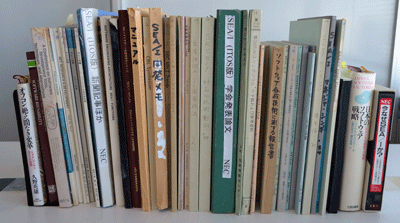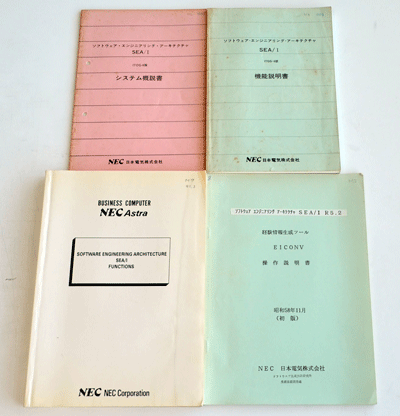

- Home >
- Artifacts of IP Heritage >
- 2016 >
- CASE Software SEA/I
CASE Software SEA/I


| Manufactured in | 1983 |
|---|---|
| Manufactured by | NEC Corporation |
| Owner | NEC Corporation |
| Location of historical materials | NEC Corporation
7-1, Shiba 5-chome, Minato-ku, Tokyo 108-8001, Japan |
| Visitor information | Not open to the public (ask for a visit) |
| Contact | Corporate Communications Division, NEC Corporation |
Software Engineering Architecture/One (SEA/I) is a Computer-Aided Software Engineering Environment (CASE) developed by NEC in 1983. The SEA/I brought in a series of innovations in the way application software was developed and maintained for the small business computers. This innovation lends itself a historical significance.
Three salient features of SEA/I include; (1) teamwork-oriented support rather than individualized workbench, with improved project management including a clue assignment, (2) a framework based on up-to-date software engineering studies including the automation of development processes, blue print visualization, and component-based build up structure, and (3) deployment of “Software Factory” concept through the full development process support instead of craft ship-based software development model.
In the small business computer market in 80s, dealers were responsible for configuring systems and developing software to make the system fully operational. However, with the Nation-wide shortage of software engineers, overloading of software engineers has been a bottleneck for increasing sales volume as well as expanding the market share.
The solution that NEC took for this issue was to develop SEA/I and to efficiently customize user’s requests as derivations from the standard application program packages. This was a disruptive innovation over the traditional approach that was enabled by SEA/I. It dramatically improved the productivity of the entire software development process that is the overall efficiency of development, delivery, and maintenance of information systems delivered as turnkey solution. Specifically, it achieved the efficient turn-key solutions by eliminating problems of software engineer overload, reducing time to finalize user requirement specification, shortening order-to-delivery interval and improving customer satisfactions that led to improved profitability. These features of SEA/I significantly contributed to faster penetration of information systems into small and medium enterprise section in Japan.
